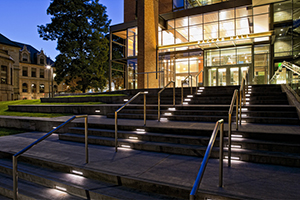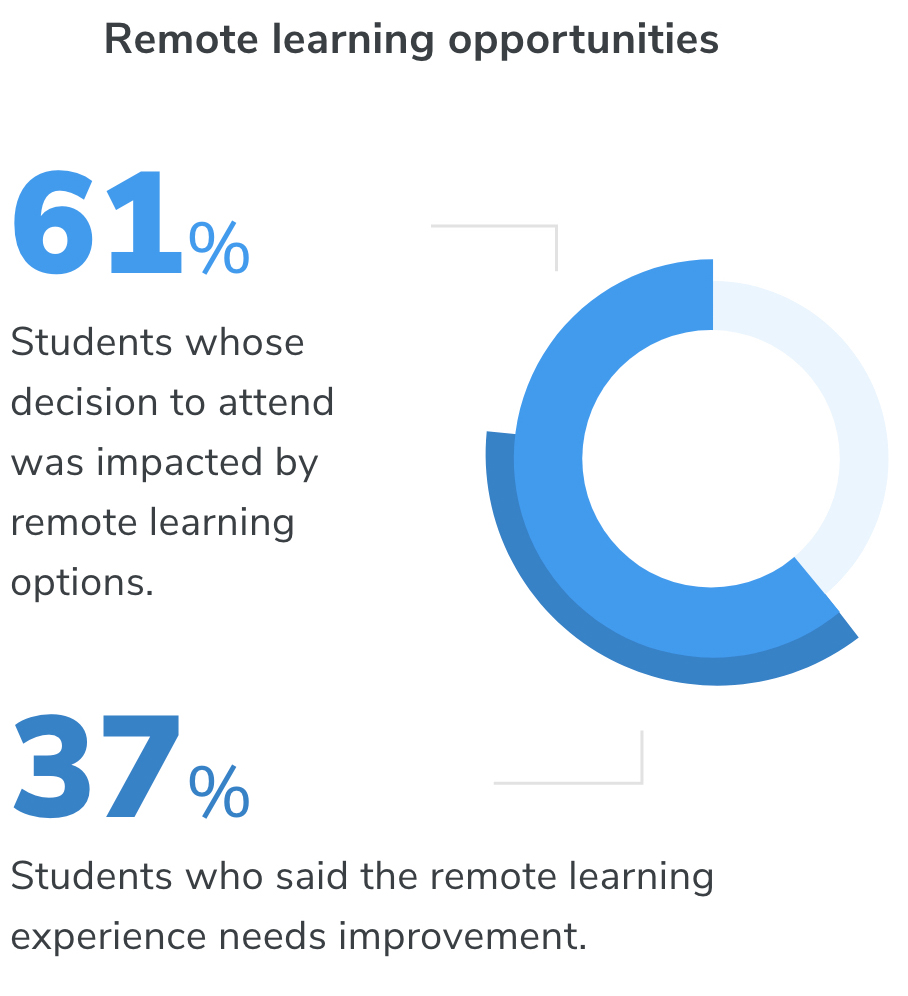
Sponsored by Ivy.ai
The COVID-19 pandemic changed the way students viewed higher education forever, and with the country reopened, students don’t necessarily want everything going back to the way it was. In some cases, students hope certain changes resulting from the
pandemic will never change.
Hybrid learning is one of the opportunities that presented itself in 2020 that students have learned to embrace. According to Ivy.ai’s The Future of Higher Ed Report,
77 percent of recent college graduates said they utilized distance learning at their institution.
Students utilized distance learning in a variety of ways. Some stayed on campus and listened to lectures in their dorms. Others moved temporarily to an Airbnb in the mountains or by the beach. Some students never went on campus and learned at home or
returned to live with their parents.
The Future of Higher Ed Report survey suggests that students don’t want to
forego the on-campus experience entirely, but they do expect more flexibility in the future. The problem is that the distance learning experience is sub-optimal. 37

percent of recent graduates said the online learning experience needed improvement.
Given that many professions have adapted to remote work faster than academia, students are observing what they may have lacked while attending their institution, and expecting to get the same accommodation from their institution.
For current higher-ed students, the benefits of learning remotely are self-evident. Students realized the advantages of online programs through extended freedoms to travel while using on-demand learning platforms and the overall flexibility in lifestyle
which remote learning offers.
Here are three strategies to help your institution better adapt to the hybrid learning environment.
Offer classes available via live-stream
Even if your institution plans to go back in person completely, professors should be encouraged to offer classes live-stream, especially for large lecture halls. If the pandemic has taught educators anything, it’s that one size doesn’t fit
all for students.
Provide students with the ability to attend classes from wherever they are, but avoid putting them in a position to feel like they’re missing something without being physically in the classroom. This not only provides students with the ability to
learn on their terms, but it’s also better all-around.
Now students who feel ill or need to travel for personal reasons no longer have to feel guilty about missing class. They can still hear the lecture from wherever they are, which will make them feel more supported at your institution.
Make ancillary services available remotely
Before COVID-19, students had to physically visit the IT office, library, or health center when a particular need arose. However, the pandemic turned everything on its head and suddenly made all of those departments work remotely.
Now that students know that they can get the support they need, they expect things to stay the same. With the Delta variant still in full force, students not only want to get support from the convenience of their dorm, but they also want to ensure that
they can safely social distance whenever possible.
Institutions need to both provide students the information to determine whether it’s safe to enter a building, and if not, give them the infrastructure to get what they need immediately. Given the option, most students would prefer to engage electronically.
The days of packed student unions and libraries are over.
Given what students have dealt with the past year and a half, there will be little appetite for any situations deemed inconvenient or may compromise their health.
Ensure Wi-Fi connectivity is available across campus
.jpg?sfvrsn=5afc6cf0_3)
Students identified technology issues as one of the biggest obstacles to their success. According to The Future of Higher Ed Report,
26 percent of recent graduates blamed spotty internet on campus, and one out of every four students pointed to a lack of technological availability.
Working without resource limits is key to success. The survey results indicate that for students to optimize their desired learning experience fully, higher-ed systems must be seamless and always available. For example, spotty Wi-Fi causes much more than
temporary annoyances. A failure in connectivity deeply impacts the ability of students to thrive academically.
Creating a suitable technological infrastructure that allows students to learn anywhere on campus greatly increases the odds of success in the classroom.
It’s time for administrators to stop thinking of libraries as the main study area for students when they could accomplish the same objective anywhere on campus. Students can, and should be able to, study in the cafeteria, near a scenic fountain,
at the gym, or even in the bleachers watching a friend’s soccer game. It’s time to strip away the limits to student learning and ensure that all areas of campus are accessible via Wi-Fi.
Hybrid learning isn’t going away. If anything, it should be a reminder that institutions must embrace digital transformation or be left behind. However, by falling these simple steps, you can better prepare your institution for the evolving expectations
of students from the first day they step on your campus.